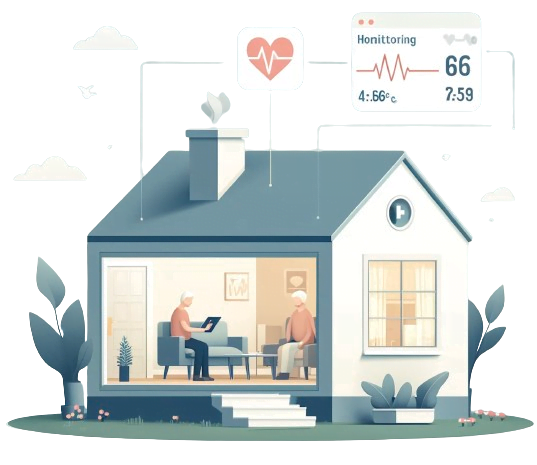Remote Home Monitoring (RHM) or Remote Patient Monitoring (RPM) is a healthcare delivery method that uses digital technologies to monitor and capture medical and other health data from patients in one location and electronically transmit that information securely to healthcare providers in a different location for assessment and recommendations. This innovative health management strategy is particularly useful for chronic disease management, post-operation monitoring, and elderly care, allowing continuous monitoring of patients without the need for them to stay in the hospital.
Empowering Continuous Care
At TebaCare, we believe in proactive and preventative healthcare. Our Remote Home Monitoring Solutions are designed to empower patients and support primary care providers with real-time data and insights, fostering a continuous care model that is both efficient and effective.
Types of Remote Patient Monitoring
Physiological Monitoring
This type involves the monitoring of basic vital signs such as heart rate, blood pressure, blood oxygen levels, and respiratory rates. Devices used include blood pressure cuffs, pulse oximeters, and wearable heart rate monitors.
Chronic Disease Management
RPM devices specifically designed for chronic conditions such as diabetes, asthma, cardiovascular diseases, and chronic obstructive pulmonary disease (COPD) fall into this category. These devices can monitor glucose levels, lung function, and real-time ECG monitoring.
Post-operative and Post-discharge Monitoring
These RPM systems monitor patients after surgeries or hospital stays to ensure that their recovery process is proceeding normally, capturing potential complications early. They can monitor wound healing, signs of infection, and overall recovery progress.
Benefits of Remote Patient Monitoring
Improved Patient Outcomes
Continuous monitoring can lead to early detection of potential health issues before they become serious, enabling prompt intervention.
Increased Accessibility
RPM provides a vital service for patients living in remote or underserved areas where traditional healthcare services might be limited.
Cost Efficiency
By reducing the need for regular physical visits and potentially decreasing hospital readmission rates, RPM can significantly lower healthcare costs.
Patient Empowerment
RPM engages patients in their healthcare processes, providing them with real-time data about their health conditions and progress, which can motivate them to take charge of their health.
Enhanced Quality of Care
Healthcare providers can offer more personalized care by having access to up-to-date patient data, leading to better management of a patient’s health.
Use Cases of Remote Patient Monitoring
Chronic Disease Management
Patients with chronic conditions like diabetes use RPM devices to monitor their blood glucose levels regularly, allowing for immediate adjustments in lifestyle or medication.
Elderly Care
RPM is used to continuously monitor elderly patients, quickly identifying issues such as falls, wandering, or health deterioration, thus allowing for immediate caregiver or emergency response.
Rehabilitation
Patients recovering from strokes or surgeries benefit from RPM by having their progress monitored, reducing the frequency of physical therapy visits while still ensuring that they are performing rehabilitation activities correctly.
Conclusion
Remote Patient Monitoring represents a transformative advancement in the field of healthcare, facilitating enhanced patient engagement, better health outcomes, and more efficient medical practices. As technology continues to advance, the scope and effectiveness of RPM are expected to grow, further integrating it into everyday healthcare practices.
Our Solutions Include:
- Vital Sign Monitoring: Track heart rate, blood pressure, oxygen saturation, and more with our state-of-the-art devices. Early detection of potential health issues allows for timely interventions.
- Medication Adherence Tools: Ensure medications are taken correctly and on schedule, reducing the risk of hospital readmissions and promoting optimal health outcomes.
- Chronic Condition Management: Specialized monitoring for conditions such as diabetes, heart disease, and COPD, enabling personalized care plans and adjustments as needed.
- Telehealth Integration: Seamless integration with our telehealth services provides a comprehensive care experience, allowing for virtual visits and consultations with healthcare professionals.
- Secure Data Portal: A user-friendly platform for patients and providers to access health data, review trends, and communicate securely.
Benefits for You
- Peace of Mind: Know that your health is being monitored and managed with the latest technology.
- Convenience: Receive high-quality care without leaving your home.
- Empowerment: Take an active role in your health with tools that are easy to use and understand.
References:
Whitehead D, Conley J. The Next Frontier of Remote Patient Monitoring: Hospital at Home. J Med Internet Res. 2023 Mar 16;25:e42335. doi: 10.2196/42335. PMID: 36928088; PMCID: PMC10132045.
